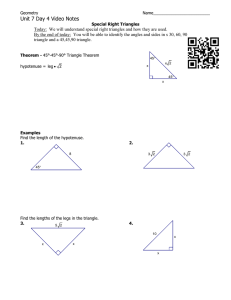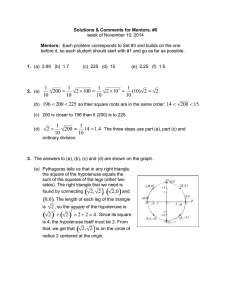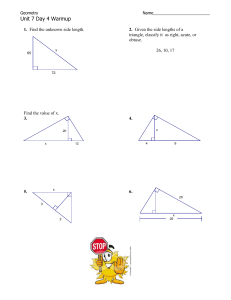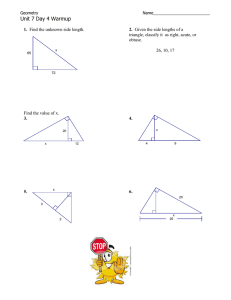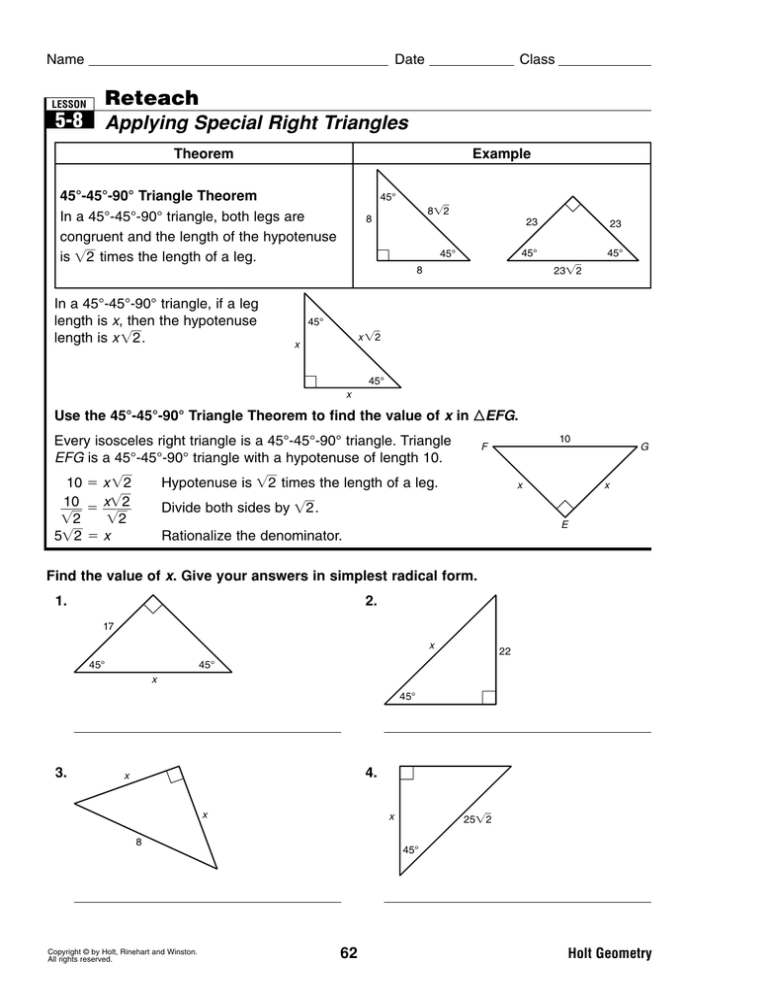
Name
LESSON
5-8
Date
Class
Reteach
Applying Special Right Triangles
Theorem
Example
45°-45°-90° Triangle Theorem
In a 45°-45°-90° triangle, both legs are
congruent and the length of the hypotenuse
is 2 times the length of a leg.
In a 45°-45°-90° triangle, if a leg
length is x, then the hypotenuse
length is x 2 .
qi
qi
X qi
X
X
Use the 45°-45°-90° Triangle Theorem to find the value of x in EFG.
Every isosceles right triangle is a 45°-45°-90° triangle. Triangle
EFG is a 45°-45°-90° triangle with a hypotenuse of length 10.
&
10 x 2
x 2
10
___ ____
2
2
5 2 x
Hypotenuse is 2 times the length of a leg.
X
'
X
Divide both sides by 2 .
%
Rationalize the denominator.
Find the value of x. Give your answers in simplest radical form.
1.
2.
X
X
x 17 2
3.
x 22 2
4.
X
X
X
qi
x 4 2
Copyright © by Holt, Rinehart and Winston.
All rights reserved.
x 25
62
Holt Geometry
Name
LESSON
5-8
Date
Class
Reteach
Applying Special Right Triangles
continued
Theorem
Examples
30°-60°-90° Triangle Theorem
In a 30°-60°-90° triangle, the length of the
hypotenuse is 2 multiplied by the length of
the shorter leg, and the longer leg is 3
multiplied by the length of the shorter leg.
qi
qi
In a 30°-60°-90° triangle, if the shorter leg
length is x, then the hypotenuse length
is 2x and the longer leg length is x.
X
X
X qi
Use the 30°-60°-90° Triangle Theorem to find the values
of x and y in HJK.
*
12 x 3
12
___ x
3
4 3 x
Longer leg shorter leg multiplied by 3 .
Divide both sides by 3 .
Y
Rationalize the denominator.
y 2x
Hypotenuse 2 multiplied by shorter leg.
(
y 2(4 3 )
Substitute 4 3 for x.
y 8 3
X
+
Simplify.
Find the values of x and y. Give your answers in simplest radical form.
5.
6.
Y
X
X
Y
x 9; y 9 3
x 2 3 ; y 4
7.
8.
Y
X
Y
X
qi
x 12 3 ; y 36
Copyright © by Holt, Rinehart and Winston.
All rights reserved.
x 11 3 ; y 22 3
63
Holt Geometry
Name
Date
Class
Name
Practice A
LESSON
5-8
5-8
�
1. The sum of the angle measures in a triangle is 180°.
Find the missing angle measure. Then use the
Pythagorean Theorem to find the length
���
of the hypotenuse.
�
�
�
45°; �2
�
3.
�
45°
2
45° �
4.
�
45°
10��
2
4��
2
2� 2
16
�
45°
60°; �3
30°
�
�
4
6. x �
y�
�
4� 3
7. x �
�
10
�
60°
60°
7
14
y�
8. x �
30°
�
�
10� 3
20
y�
9. Andre is building a structure out of playing cards. Each card
is 6.3 centimeters long. He tries leaning the cards against
each other so that the angle at the top is 90°. Find the
distance between the edges of the cards to the nearest tenth.
10. Andre tries leaning the cards against each
other so the angle at the top is 60°. Find the
height x of the tops of the cards.
90°
6.3 cm
90°
�
���
5.5 cm
triangle whose hypotenuse is the length of one of the legs of the larger
�
57�2 inches or about 10 inches, so
triangle. The height of the alcove is _____
8
He can probably not lay a card across the top of the structure in
Exercise 10 because 6.3 cm is the distance between two consecutive
the statues could have been placed in the alcoves.
peaks, and there should be some overlap for the card to stay.
Name
LESSON
5-8
Date
Holt Geometry
Class
Name
LESSON
5-8
Applying Special Right Triangles
Multiply and simplify. Assume a and b are nonnegative.
a�b
2
�
30°
�
4.
5.
60°
Theorem
�
��4
Example
45°-45°-90° Triangle Theorem
In a 45°-45°-90° triangle, both legs are
congruent and the length of the hypotenuse
�
is � 2 times the length of a leg.
��4
�°
2�°
�
Holt Geometry
Class
Applying Special Right Triangles
2
Find the value of x in each figure. Give your answers in simplest radical form.
3.
Date
Reteach
a �b
�
2. (a � �b)(a � � b) �
60
Copyright © by Holt, Rinehart and Winston.
All rights reserved.
Practice C
a � b)(��
a � b) �
1. (��
3
y�
perpendicular to the hypotenuse. This makes another smaller 45°-45°-90°
Andre cannot lay a
card across the top of the structure in Exercise 9 because 6.3 cm � 8.9 cm.
59
�
�3
6. x �
Possible answer: To find the height of a 45°-45°-90° triangle, draw a
11. Tell whether Andre can lay another card across the peaks of
the structures he built in Exercises 9 and 10. Possible answer:
Copyright © by Holt, Rinehart and Winston.
All rights reserved.
�
8� 3
y�
inches
16
tall. She wonders whether the statues might have been placed in the alcoves. Tell
whether this is possible. Explain your answer.
������
����� ���
��
�
4�3
8. Lucia also finds several statues around the building. The statues measure 9
8.9 cm
���
������
5. x �
Possible answer: Lucia’s hypothesis cannot be correct. The base of the
�
57�2 inches or just over 20 inches long, so a 22 _1_-inch tablet
alcove is _____
4
8
could not fit.
7
___
For Exercises 9 and 10, use a calculator to find each answer.
6.3 cm
�
20� 3
7. Around the perimeter of the building, Lucia finds small alcoves at regular intervals carved
into the stone. The alcoves are triangular in shape with a horizontal base and two sloped
equal-length sides that meet at a right angle. Each of the sloped sides measures 14 _1_
4
inches. Lucia has also found several stone tablets inscribed with characters. The stone
tablets measure 22 _1_ inches long. Lucia hypothesizes that the alcoves once held the stone
8
tablets. Tell whether Lucia’s hypothesis may be correct. Explain your answer.
7��
3
�
y�
2� °
2��
3
Lucia is an archaeologist trekking through the jungle of the Yucatan
Peninsula. She stumbles upon a stone structure covered with creeper
vines and ferns. She immediately begins taking measurements of her
discovery. (Hint: Drawing some figures may help.)
�
8
30
4. x �
�
�
�°
60°
�
In a 30°-60°-90° triangle, the hypotenuse is the length of the shorter
leg multiplied by 2, and the longer leg is the length of the shorter leg
�
multiplied by �3. Find the values of x and y.
30°
�
�
�
30°
���
�
2
12
10��
3
10
�
�
7� 2
____
2
Find the values of x and y. Give your answers in simplest radical form.
4
5. Find the missing angle measure. Then use the
Pythagorean Theorem to find the length of the
hypotenuse.
60°
�
�
�
45°
�
10
45°
45°
2��
2
7
�
45° �
In a 45°-45°-90° triangle, the legs have equal length and the hypotenuse
�
is the length of one of the legs multiplied by �2. Find the value of x.
2
Applying Special Right Triangles
Find the value of x in each figure. Give your answer in simplest
radical form.
2.
3.
1. 8��2
��
�
Class
Practice B
LESSON
Applying Special Right Triangles
2.
Date
���
���
�
�
���
��
��
���
���
�
�����
��4
�
4
6.
�
2�3 � 2
7.
�
�
8�3 � 12
8.
30°
4�2 � 4
1
1
�
�2
���
_1_
�
Use the 45°-45°-90° Triangle Theorem to find the value of x in �EFG.
2
Every isosceles right triangle is a 45°-45°-90° triangle. Triangle
EFG is a 45°-45°-90° triangle with a hypotenuse of length 10.
Greg is a modeling enthusiast. He is working on modeling some
geometric shapes, but he finds he doesn’t have a ruler to take
measurements. In Greg’s desk drawer, he finds a protractor, a
straightedge, and a pencil. For Exercises 9 and 10, use 30°-60°-90°
and/or 45°-45°-90° triangles to accomplish each task.
�
�
�
Rationalize the denominator.
2.
��
�
���
��
���
�
���
�
�
x � 17 �2
���
��
�
� �
�
��
�
3.
x � 22 � 2
4.
�
�
�
�
30°-60°-90° triangle. The shorter leg of this second triangle then has
length _1_x. Use that leg as the longer leg of a third 30°-60°-90° triangle.
3
This smallest triangle has sides that are exactly one-third the length of
the original.
Copyright © by Holt, Rinehart and Winston.
All rights reserved.
�
�
�
Divide both sides by �2.
1.
���
Possible answer: Name the length of the longer leg in �
�
�3 x.
���
a 30°-60°-90° triangle x. The shorter leg has length ___
3
Use the shorter leg of the original triangle as the longer leg of another
61
Hypotenuse is �2 times the length of a leg.
Find the value of x. Give your answers in simplest radical form.
Possible answer: Use one of the legs of the original 45°-45°-90° triangle
as the shorter leg of a 30°-60°-90° triangle. The hypotenuse of the
30°-60°-90° triangle will then have twice the length of one of the legs
of the 45°-45°-90° triangle. Then draw a 45°-45°-90° triangle with a leg
as the hypotenuse of the 30°-60°-90° triangle. This larger 45°-45°-90°
triangle has legs with exactly twice the length of the original 45°-45°-90°
triangle.
10. Describe how Greg can draw an exact 1 : 3 replica of a 30°-60°-90°
triangle. Sketch an example.
��
�
�
10 � x � 2
�
x� 2
10 � ____
___
�
�
�2
�2
�
5� 2 � x
9. Describe how Greg can draw an exact 2 : 1 replica of a 45°-45°-90° triangle.
That is, he will draw a triangle that has double the length of each side in the
original triangle. (Hint: Look back at Exercise 8.)
Copyright © by Holt, Rinehart and Winston.
All rights reserved.
� ���
�
45°
60°
�
���
�
45°
�
��4
In a 45°-45°-90° triangle, if a leg
length is x, then the hypotenuse
�
length is x �2.
�
x � 4 �2
Holt Geometry
Copyright © by Holt, Rinehart and Winston.
All rights reserved.
81
�����
���
x � 25
62
Holt Geometry
Holt Geometry
LESSON
5-8
Reteach
LESSON
Applying Special Right Triangles
5-8
continued
Theorem
Challenge
Applying Properties of Special Right Triangles
Use the properties of special right triangles to solve each problem.
Give your answers in simplest radical form.
Examples
30°-60°-90° Triangle Theorem
In a 30°-60°-90° triangle, the length of the
hypotenuse is 2 multiplied by the length of
the shorter leg, and the longer leg is 兹 3
multiplied by the length of the shorter leg.
1. The circumference of circle J is 14.
What is the value of x ?
qi
qi
In a 30°-60°-90° triangle, if the shorter leg
length is x, then the hypotenuse length
is 2x and the longer leg length is x.
+
2. The area of semicircle D is 18. What is
the perimeter of 䉭ABC?
#
X
*
$
,
30°
X
"
X
!
18 6兹 3
7兹 2
X qi
Use the 30°-60°-90° Triangle Theorem to find the values
of x and y in 䉭HJK.
*
3. Find the perimeter of quadrilateral WXYZ.
12 ⫽ x 兹3
12 ⫽ x
___
兹3
4兹 3 ⫽ x
Longer leg ⫽ shorter leg multiplied by 兹 3.
y ⫽ 2x
Hypotenuse ⫽ 2 multiplied by shorter leg.
Divide both sides by 兹3.
Y
7
1
2
18qi
Rationalize the denominator.
X
Substitute 4 兹3 for x.
45°
:
+
43
9
3
86 18兹 2
Simplify.
2
36qi
2
60°
4
(
y ⫽ 2(4 兹3)
y ⫽ 8 兹3
4. Find the perimeter of quadrilateral QRST
8
72 36兹 6
Find the values of x and y. Give your answers in simplest radical form.
5.
6.
Y
X
5. Find a, b, c, and d.
X
x 2 兹3 ; y 4
7.
+ (7, 0)
30°
X
60°
& (0, 0)
!(0, 0)
* (C, D )
8.
a 7, b 4兹 3 , c 11, d 0
Y
X
& (S, 0)
%(Y, 0)
X
$ (Z, 0)
w 13, x 13, y 20,
z 20 13兹 3
Y
X
# (20, V )
2 45°
13qi
x 9; y 9兹 3
qi
x 12 兹 3 ; y 36
x 11 兹 3 ; y 22兹3
63
Copyright © by Holt, Rinehart and Winston.
All rights reserved.
5-8
" (W, X )
LESSON
( (A, B)
' (0, 4qi
3)
Y
6. Find w, x, y, and z.
Y
Y
Holt Geometry
Problem Solving
LESSON
Reading Strategies
5-8
Making Generalizations
Applying Special Right Triangles
45°
45°
2
12兹 3 in. or about 20.8 in.
2. To secure an outdoor canopy, a 64-inch cord is extended
from the top of a vertical pole to the ground. If the cord
makes a 60° angle with the ground, how tall is the pole?
IN
2
10
_
Find the length of AB in each quilt pattern.
2
⫹
2
10
200
10
10
10
2
10
⫽ c2
⫽c
2
10
c ⫽
兹2
1. What is the length of a diagonal of a square with a
side length of s?
!
3 in.
2
a ⫹b ⫽c
4.
"
2
Use the Pythagorean Theorem to find the length of
the hypotenuse of one of the triangles formed by
drawing a diagonal on this square.
2
Now consider the Pythagorean Theorem: a ⫹ b ⫽ c
32兹 3 in. or about 55.4 in.
3.
Holt Geometry
To make a 45⬚-45⬚-90⬚ triangle, start with a simple square. Possible drawing:
Draw a diagonal through the square to form two 45⬚ angles:
For Exercises 1–6, give your answers in simplest radical form.
1. In bowling, the pins are arranged in a pattern
based on equilateral triangles. What is the
distance between pins 1 and 5?
64
Copyright © by Holt, Rinehart and Winston.
All rights reserved.
s 兹2
30°
! 3 in.
4 in. "
8 兹 3 in. or about 4.6 in.
_____
3兹 2 in. or about 4.2 in.
Now consider the following
equilateral triangle.
3
10
Choose the best answer.
10
5. An equilateral triangle has an altitude of
21 inches. What is the side length of
the triangle?
6. A shelf is an isosceles right triangle, and
the longest side is 38 centimeters. What
is the length of each of the other two sides?
3. Draw an altitude in this triangle.
19 兹2 cm
Use the figure for Exercises 7 and 8.
Assume 䉭JKL is in the first quadrant, with m⬔K ⫽ 90⬚.
Y
_
* (2, 7)
_
7. Suppose that JK is a leg of 䉭JKL, a 45⬚-45⬚-90⬚
triangle. What are possible coordinates of point L?
A (6, 4.5)
C (6, 2)
B (7, 2)
D (8, 7)
60
2. What is the measurement of each angle in this triangle?
14 兹 3 in.
4. What are the angle measurements of the two triangles you have formed?
3
Students should say that they have created two 30-60-90 triangles.
+ (2, 2)
X
0
3
8. Suppose 䉭JKL is a 30⬚-60⬚-90⬚ triangle and JK
is the side opposite the 60° angle. What are the
approximate coordinates of point L?
F (4.9, 2)
G (4.5, 2)
10
5. Use the Pythagorean Theorem to find the length of the altitude.
The altitude is 5 兹 3 .
H (8.7, 2)
J (7.1, 2)
Copyright © by Holt, Rinehart and Winston.
All rights reserved.
65
Copyright © by Holt, Rinehart and Winston.
All rights reserved.
001-082_Go07an_CRB_c05.indd 82
Holt Geometry
Copyright © by Holt, Rinehart and Winston.
All rights reserved.
82
66
Holt Geometry
Holt Geometry
5/1/06 1:28:16 PM
Process Black


